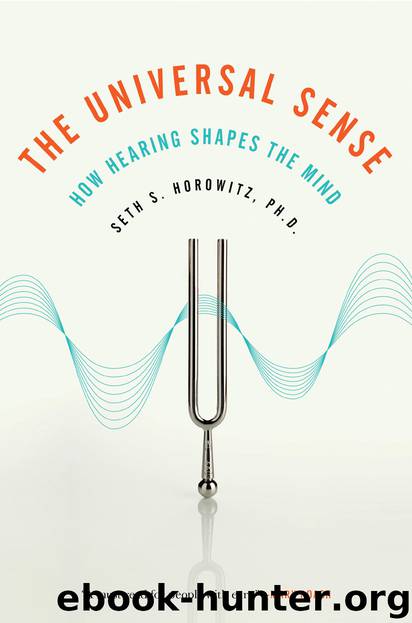The Universal Sense: How Hearing Shapes the Mind by Seth S. Horowitz & Seth Horowitz

Author:Seth S. Horowitz & Seth Horowitz [Horowitz, Seth S. & Horowitz, Seth]
Language: eng
Format: epub
ISBN: 9781608190904
Publisher: Bloomsbury USA
Published: 2012-09-04T00:00:00+00:00
Chapter 7
Sticky Ears: Soundtracks, Laugh Tracks, and Jingles All the Way
One of the first things you have to think about when you start a career in science is whether your focus is going to be on basic or applied research. People who want to do basic research are those who like puzzles—they pick a specific problem and want to solve it. Those who are interested in applied research tend to want to see their work help solve some real-world problem. But the wonderful thing about such a universal field as sound perception is that even the most obscure aspect can end up having real-world applications. It’s just a question of what part of the world you’re improving, whether it’s using the psychophysics of audiograms and critical bands to develop the MP3 compression algorithm or doing detailed recordings of the environment around someone’s head to create surround sound systems. But our most powerful research tools for auditory science are not fMRIs or EEGs—they are our ears and our brains. And there is a very long history of applying auditory principles to things in our everyday life to get directed emotional or attentional responses from listeners.
One of the most common large-scale formats for controlling emotional responses is movies. Aside from the kind of blasé educational films we are forced to watch in school, almost all films, TV, video games, and other multimedia are about directing attention and inducing an emotional response in the audience. While the first films were developed around 1880 by Eadweard Muybridge, an experimental photographer known mostly for his pioneering work in analyses of animal and human locomotion, the first films shown to a general audience were presented in 1893. They were totally silent. If you have access to a film library showing some of these very early silent films, watch them and try to figure out why they come across as kind of flat.36 The complete lack of sound removes some essential underlying drive, which is why theaters started adding live musical accompaniments almost immediately, ranging from live piano players in small houses to pipe organs in the larger ones. Once movies became a serious industry, original scores were often created to be performed by entire orchestras as a real-time soundtrack for the film, starting with Joseph Carl Breil’s score for D. W. Griffith’s Birth of a Nation in 1915 and, arguably, culminating in Gottfried Huppertz’s score played for the premiere of Fritz Lang’s Metropolis in 1926.37
It might seem odd to think of movies as applied neuroscience and psychology, but “neurocinema” is very trendy these days as a tool for examining how people’s brains react to films in order to improve their effectiveness. One approach that’s being taken by a San Diego group called MindSign Neuromarketing is to have people watch a short section of film and then examine their brain blood flow in an fMRI, usually focusing on the amygdala after watching a horror film. This is a very sexy approach, but it has some important limitations. For one, it’s very expensive.
Download
This site does not store any files on its server. We only index and link to content provided by other sites. Please contact the content providers to delete copyright contents if any and email us, we'll remove relevant links or contents immediately.
The Complete Stick Figure Physics Tutorials by Allen Sarah(7334)
Secrets of Antigravity Propulsion: Tesla, UFOs, and Classified Aerospace Technology by Ph.D. Paul A. Laviolette(5330)
Thing Explainer by Randall Munroe(3905)
The River of Consciousness by Oliver Sacks(3569)
The Order of Time by Carlo Rovelli(3162)
How To by Randall Munroe(3074)
A Brief History of Time by Stephen Hawking(2990)
I Live in the Future & Here's How It Works by Nick Bilton(2957)
What If?: Serious Scientific Answers to Absurd Hypothetical Questions by Randall Munroe(2667)
The Great Unknown by Marcus du Sautoy(2661)
Midnight in Chernobyl by Adam Higginbotham(2515)
Blockchain: Ultimate Step By Step Guide To Understanding Blockchain Technology, Bitcoin Creation, and the future of Money (Novice to Expert) by Keizer Söze(2465)
Networks: An Introduction by Newman Mark(2382)
The Meaning of it All by Richard Feynman(2317)
Easy Electronics by Charles Platt(2304)
The Tao of Physics by Fritjof Capra(2247)
Midnight in Chernobyl: The Untold Story of the World's Greatest Nuclear Disaster by Adam Higginbotham(2195)
When by Daniel H Pink(2098)
Introducing Relativity by Bruce Bassett(2097)
